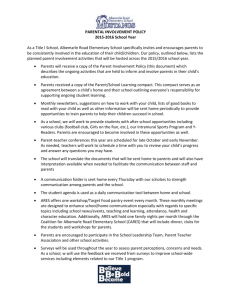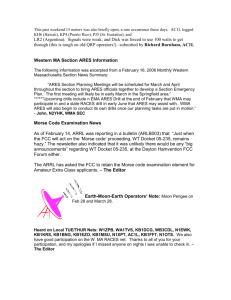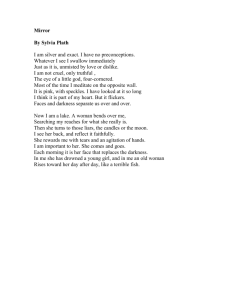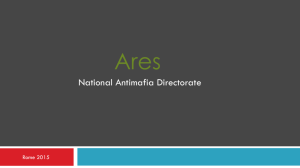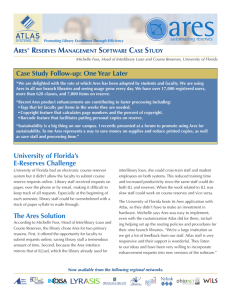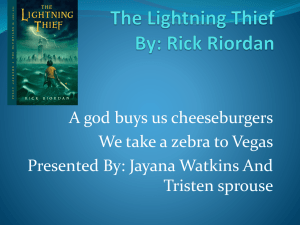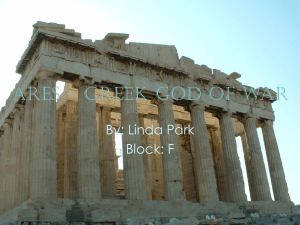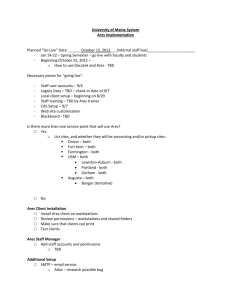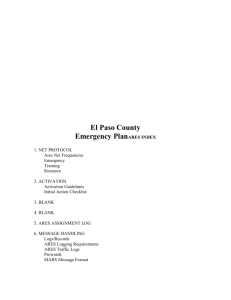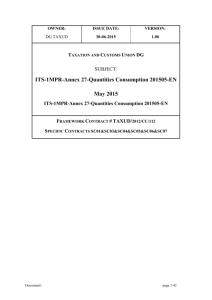Syllabus
advertisement
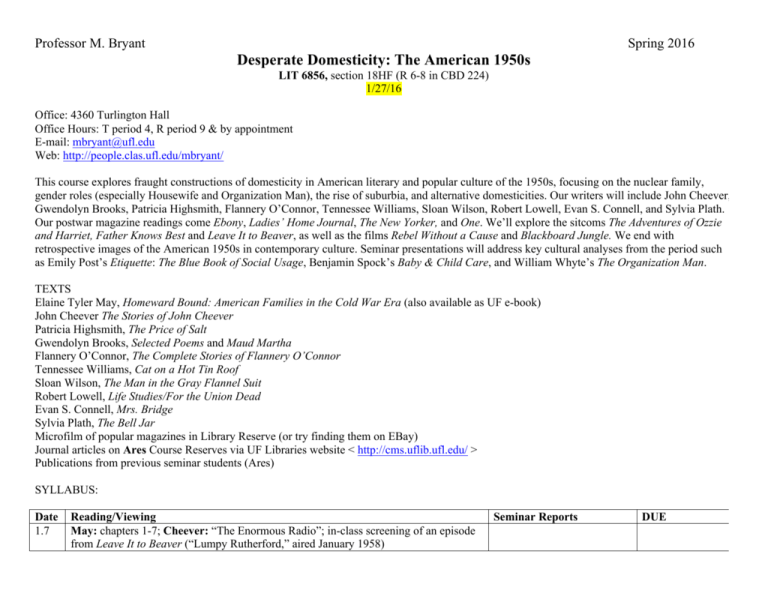
Professor M. Bryant Spring 2016 Desperate Domesticity: The American 1950s LIT 6856, section 18HF (R 6-8 in CBD 224) 1/27/16 Office: 4360 Turlington Hall Office Hours: T period 4, R period 9 & by appointment E-mail: mbryant@ufl.edu Web: http://people.clas.ufl.edu/mbryant/ This course explores fraught constructions of domesticity in American literary and popular culture of the 1950s, focusing on the nuclear family, gender roles (especially Housewife and Organization Man), the rise of suburbia, and alternative domesticities. Our writers will include John Cheever, Gwendolyn Brooks, Patricia Highsmith, Flannery O’Connor, Tennessee Williams, Sloan Wilson, Robert Lowell, Evan S. Connell, and Sylvia Plath. Our postwar magazine readings come Ebony, Ladies’ Home Journal, The New Yorker, and One. We’ll explore the sitcoms The Adventures of Ozzie and Harriet, Father Knows Best and Leave It to Beaver, as well as the films Rebel Without a Cause and Blackboard Jungle. We end with retrospective images of the American 1950s in contemporary culture. Seminar presentations will address key cultural analyses from the period such as Emily Post’s Etiquette: The Blue Book of Social Usage, Benjamin Spock’s Baby & Child Care, and William Whyte’s The Organization Man. TEXTS Elaine Tyler May, Homeward Bound: American Families in the Cold War Era (also available as UF e-book) John Cheever The Stories of John Cheever Patricia Highsmith, The Price of Salt Gwendolyn Brooks, Selected Poems and Maud Martha Flannery O’Connor, The Complete Stories of Flannery O’Connor Tennessee Williams, Cat on a Hot Tin Roof Sloan Wilson, The Man in the Gray Flannel Suit Robert Lowell, Life Studies/For the Union Dead Evan S. Connell, Mrs. Bridge Sylvia Plath, The Bell Jar Microfilm of popular magazines in Library Reserve (or try finding them on EBay) Journal articles on Ares Course Reserves via UF Libraries website < http://cms.uflib.ufl.edu/ > Publications from previous seminar students (Ares) SYLLABUS: Date 1.7 Reading/Viewing May: chapters 1-7; Cheever: “The Enormous Radio”; in-class screening of an episode from Leave It to Beaver (“Lumpy Rutherford,” aired January 1958) Seminar Reports DUE 1.14 Cheever stories: “The Season of Divorce “The Cure,” “The Sorrows of Gin,” “O Youth and Beauty!” “The Five-Forty-Eight,” “The Housebreaker of Shady Hill,” “The Worm in the Apple,” “The Trouble with Marcie Flint,” “The Wrysons,” “The Country Husband,” “Just Tell Me Who It Was,” + New Yorker issue: Aug. 22, 1953 (Ares) + Trysh Travis, “What We Talk About When We Talk about The New Yorker” (Ares) Highsmith: The Price of Salt + trailer to Carol <YouTubelink> + this recent New Yorker piece on Highsmith’s novel: http://www.newyorker.com/magazine/2015/11/30/forbidden-love #1: Emily Post, Etiquette: The Blue Book of Social Usage (1945 ed.): any 250300 pages, including “Mrs. Three-in-One” #2: Ferdinand Lundberg & Marina F. Farnham, Modern Woman: The Lost Sex (1947) 1.28 Brooks: Selected Poems through “The Ballad of Rudolph Reed” + Maud Martha + Ebony issue: November 1950 (Ares) 2.4 50s Family Sitcoms: episodes from Ozzie and Harriet -“The Pancake Mix” (1953) & “The Bird’s Nest” (1954); Father Knows Best, - “Lesson in Citizenship” (1954) & “Jim the Farmer” (1955); I Love Lucy - “Lucy Goes to the Hospital” (1953); The Honeymooners - “Head of the House” (1956). *Check listserv email for viewing instructions; we’ll see another episode of Leave it to Beaver in class. )* + Ladies’ Home Journal issue (February 1956) + Ebony issue (December 1957) - Ares O’Connor stories: “A Stroke of Good Fortune,” “A Good Man Is Hard to Find,” “The Life You Save May Be Your Own,” “A Temple of the Holy Ghost,” “Good Country People,” “Greenleaf,” “A View of the Woods,” “The Enduring Chill,” “The Comforts of Home” Williams: Cat on a Hot Tin Roof + 1958 film version (on Library Reserve, Netflix and YouTube) Gilbert: “Mendacity: Men, Lies, and Cat on a Hot Tin Roof” (Ares) + New Yorker issue: April 2, 1955 (Ares) + 2 issues of the journal One, available full-text thru UF library: Vol. 3.1 (January 1955) & Vol. 3.4 (April 1955) *Meet in Library East Grand Reading Room at 1:00!* Clarke: “‘Parties Are the Answer”: The Ascent of the Tupperware Party” (Ares) + explore Tupperware on these websites: www.moma.org and http://www.pbs.org/wgbh/americanexperience/films/tupperware/ NO CLASS: Spring Break! Wilson: The Man in the Gray Flannel Suit (1955) + Season 1.1 episode of Mad Men (on Netflix instant, Amazon, etc.) Teen Films: Rebel Without a Cause (1955, on Library Reserve, YouTube, Netflix DVD) + Blackboard Jungle (1955, on Library Reserve YouTube) + Ramona Caponegro: “Where the ‘Bad’ Girls Are (Contained)” (Ares) #3: Arna Bontemps & Jack Conroy, They Seek a City (1945) #4: Benjamin Spock, Baby & Child Care (1957) 1.21 2.11 2.18 2.25 3.3 3.10 3.17 #5: Marshall McLuhan, The Mechanical Bride (1967 ed.) #6: Alfred Kinsey, Sexual Behavior and the Human Male (1948), Part 2 only Archive Worksheet (inlibrary activity) #7: William Whyte, The Organization Man (1956) #8: Dorothy Baruch, How to Live with Your Teenager (1953) Conference Paper Proposal 3.24 3.31 4.7 4.14 4/27 Lowell: Life Studies + Michael Kimmel’s book chapter “‘Temporary About Myself’: White-Collar Conformists and Suburban Playboys, 1945-1960” (Ares) Connell: Mrs Bridge (guest co-leader: Michael Hofmann) + Ladies’ Home Journal, December 1958 (Ares) (14) Plath: The Bell Jar + these poems: “The Applicant,” “Cut,” “Lesbos” + Andrea Krafft: “‘Funny and Tender and Not a Desperate Woman:’ Sylvia Plath's The Bell Jar, Betty Friedan's The Feminine Mystique, and Therapeutic Laughter” (Plath Profiles 6, 2013; available online) + Renee Dowbnia: “Consuming Appetites: Food, Sex, and Freedom in Sylvia Plath’s The Bell Jar” (Ares) *Meet at the Bryant-Pierce house* Matchar: “June Cleaver 2.0: Bloggers and the Rise of Domestic Chic” (Ares) Seminar Luncheon & Movie Gathering! Meet Marsha’s dog, Vinnie! Submit by High Noon in Marsha’s Department or Home mailbox #9: Philip Wylie, Generation of Vipers (1955 ed.) #10: David Riesman, The Lonely Crowd (1950) #11: Betty Friedan, The Feminine Mystique (1963) Seminar Papers Guidelines for ASSIGNMENTS Seminar Report (20 minutes + Q&A) Discuss the overall argument/value judgments of your postwar text, connecting it with relevant 50s material we’ve studied thus far. Highlight a few especially interesting examples for the class, and point out the key strengths and problems that you find. Do any aspects of your text connect with contemporary American culture? Which aspect of the book/magazine did you find most surprising? Prepare a 1-page handout that gives full bibliographic information of your text, an overview of key points, and a key excerpt or image. Be prepared to field a few audience questions. Conference Paper Proposal (2 d.s. pages, by email attachment) Find an upcoming conference suitable for your seminar paper topic and address the proposal to the appropriate person. Panel organizers want to know: (1) What is the paper’s overall argument & key issues/contexts?; (2) What fresh insights will you bring to the topic? (3)Which critics, theorists, reviewers, and/or artists are most useful/not useful to your argument and why?; (4) What’s an intriguing example or 2 that illustrates your approach? Bottom line: why should the panel organizer select your paper? Will the implications of your analysis be broad enough to connect with other papers and interest a diverse audience? A good place to find Calls for Papers announcements (CFPs) is the link on my website. You can also find them through professional organizations such as the MLA, SCMS, AWP, ASA, and CSA. Seminar Paper (22-25 pages, hard copy) Formulate a focused and lively argument that engages any of the texts, contexts, and/or issues in our course. While my feedback on your paper proposal will provide some guidelines, you should also discuss your topic with me before beginning extensive work on the paper. You should cite relevant criticism, reviews, and/or theory on your materials since 2005 (a more authoritative paper would be informed by a wider range of secondary sources). You may also find useful some of the materials on course reserve in Library West. Please use MLA documentation style, and pitch your argument so that it interests a diverse academic audience who may not be familiar with your primary materials. Think of this as a project that will yield future work (a conference paper, academic or creative thesis, dissertation chapter, article, blog post) rather than merely an end in and of itself that fulfills a course requirement. In short, this is graduate rather than undergraduate work. I look forward to reading it. Note: MFA students have the option of submitting a 10-12 page conference paper and a 10-12 page creative response. No exceptions.

